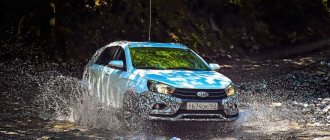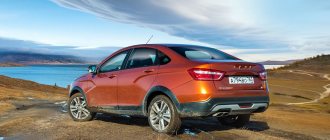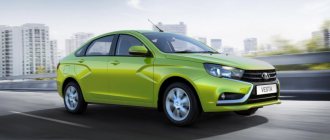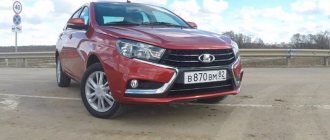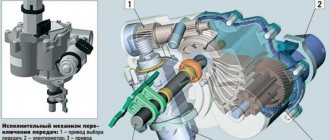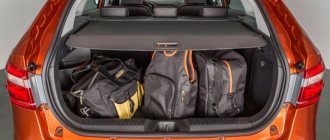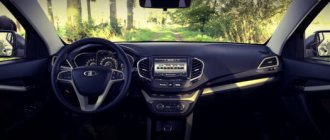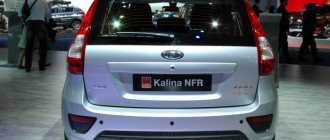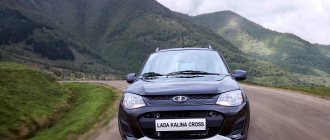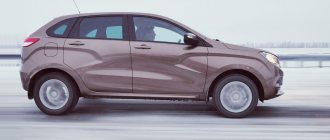On September 19, AVTOVAZ announced the price for Lada Vesta SW and Lada Vesta SW Cross, and all LADA dealers began accepting orders for these cars. At the end of September, AVTOVAZ provided station wagons for the first official test drive to leading auto media. The tests were carried out by real automotive experts in the city of Sochi.
Autoreview
It is beautiful, but not cheap, handles well, but accelerates poorly, practical, but voracious.
Suspension
:
- The suspension of the Lada Vesta SW and Lada Vesta SW Cross is different. On the cross version it is more “asphalt”.
- The suspension is denser, reactions are faster and more accurate, with it Vesta Cross rolls less and sways less.
- But it emphasizes waves and irregularities more strongly.
Control
:
- The elevated Cross controls more accurately and tastes better.
- The cross costs 830 thousand, but drives like a million. Reactions are fast and accurate, rolls are almost not felt.
Clearance
:
- Ground clearance is 203 mm - Crete never dreamed of this, and Kaptur is only one millimeter higher, but from experience there is more confidence in the Lada's passport clearance.
Noise insulation
:
- Unexpectedly good sound insulation (in a station wagon it is almost quieter than in a sedan).
- The roar of the engine is insipid, the turn signals click poorly, the horn snarls in the voice of a cold teenager.
Body:
- The rigidity of the station wagon body compared to the sedan dropped by only 100 Nm/deg and amounts to 17900-18900 Nm/deg. To compensate for the lack of a rigid rear shelf, the design has several additional elements that strengthen the body.
- We hung one wheel, all doors open and close without problems.
Fuel consumption
the Cross version in mountainous areas floated from 12 to 14 liters per 100 km.
Link #1 and link #2 for a test drive.
Passive and active safety aspects
These concepts are inextricably linked to the design features of the vehicle and contribute to overall safety.
Passive safety systems usually include:
- brake mechanisms;
- steering control unit, with both hydraulic and electrical amplification principles;
- systems responsible for directional stability and stabilization of car behavior in corners (anti-skid);
- "ABS" etc.
The indicated list of devices and systems is designed to prevent the vehicle from getting into an emergency situation.
Now let's look at the active safety elements:
- impact energy-absorbing side members;
- body components with increased rigidity;
- pillows and curtains in the cabin;
- belts with pre-tensioning functions;
- glass that does not shatter into fragments upon impact.
These systems protect human life at the time of an accident.
Behind the wheel
Suspension
:
- The regular Vesta SW station wagon has a rear suspension exactly like a sedan, but the characteristics of the springs and shock absorbers have been slightly revised for higher loads.
- Cross has different springs: thanks to them, the ground clearance is increased from 178 to 203 mm.
- This is the first production Lada with suspension like Subaru!
- There was not even a hint of a breakdown on any of the asphalt waves and holes that abound on the narrow mountain road to Solohaul (a famous rally stop!).
Engine and transmission
:
- The combination of a 122-horsepower engine and a manual transmission is fire! There is always enough engine, although there are three passengers in the car besides me and some luggage.
- The clutch does not require filigree footwork: you just release the pedal and go.
- Only occasionally did a slight itch irritate me, but this, as the engineers assured me, was a consequence of the fact that the engine calibration had not yet been completed.
Control
:
- The strength of the Cross is also that it handles perfectly - better than a sedan.
- ESC is triggered later than on a sedan, allowing you to drive a little more actively and slide longer without the intervention of an electronic guard (due to the fact that ESC is triggered, among other things, by the steering angle sensor + low-profile tires).
- Low-profile tires, with a stiffer sidewall, so when turning the steering wheel you deflect at smaller angles - the car changes course more readily and turns more actively into turns than on higher and softer tires.
- Active drivers will like it - you can afford a little more than usual. Living machine!
Brakes
:
- For ESP operation, disc brakes are preferable: they are faster, especially on rough roads.
Body
:
- The torsional rigidity of the body (on an empty car) is sufficient. The rear right wheel is a couple of millimeters off the ground, but all the doors, including the trunk, open easily.
Link to test drive.
Auto.mail.ru
Engine
:
- “Vesta” with the flagship engine (1.8 l, 122 hp), to put it mildly, did not please. In the mountains below the engine is empty, at the top it’s sad, the middle is so-so - no matter what speed you hold, sometimes the car not only didn’t want to accelerate on the climbs, it demanded to switch to a downshift. It’s doubly stressful to crawl along a country road - you have to play with the clutch like a jewel.
- In the morning, the cold engine upset me a couple of times with unexpected drops in traction.
Fuel consumption
:
- In mountainous areas, consumption was 12-13 liters of 92 gasoline. The on-board computer never showed anything below 9 liters the entire time.
Transmission
:
- I liked the Renault JR5 manual transmission: it shifts quite clearly, easily, does not buzz or howl.
Control
:
- Lada Vesta SW. This version resembles a sedan in its behavior on the road. The steering wheel is just as tight, with excitement it turns into a turn when releasing the gas and pleases with a lively response to steering turns.
- Lada Vesta SW Cross turned out to be even more interesting! The “off-road” version did not become any more rolly, retained an acceptable ride on low-profile 17-inch wheels, and even benefited in handling: the “Cross” has a cleaner steering wheel, a richer force on it, and the car is more stable in an arc during a turn.
- On the serpentine road, the front tires of the Cross were rubbing against the support cups of the suspension springs. We hope this is an isolated problem with our car.
- Never before have Russian station wagons driven so deliciously.
Link to test drive.
Convenience and design
In matters of convenience, Lada Vesta also turned out to be above all praise. The ability to adjust the steering column by rollout, although not implemented in the best way, is still there - you just need to get used to the inconvenient control element. I was also pleased with the size of the interior, which is explained by the flagship dimensions of the body - both the driver and passengers have the necessary amount of space for both legs and head. The rear sofa, which received a slightly lower backrest than other cars in the class, received in return a third headrest for the central passenger (and, importantly, it in no way affected the quality of the view in the rear-view mirror located in the cabin).
The trunk has a fairly good volume - 480 liters, although Vesta is inferior in this indicator to some of its direct competitors. The slight loss in luggage compartment size is compensated by the more convenient placement of the wheel arches - they do not protrude so much into the trunk, allowing you to place more large bags and suitcases.
As for the design, it pleased connoisseurs of beauty even in the basic configuration, without any tuning elements. The stamping on the front and rear fenders, the design of the optics and radiator grille, the overall smoothness and sportiness of the Lada Vesta's outline undoubtedly make this car one of the most attractive in the budget category. For lovers of all sorts of bells and whistles, it is worth noting that additional option packages are available in the medium and maximum configurations, including enlarged alloy wheels for low-profile tires, linings, moldings, stickers and spoilers.
The main issue concerns pricing policy. It is quite difficult to say how much the Lada Vesta costs at the start of sales, since the general director of AvtoVAZ, Bo Inge Andersson, announced the nominal value of the Vesta at 400 thousand rubles before the emergence of problematic economic factors for Russia. According to experts, we should expect an increase in the announced price to 450-500 thousand rubles for the basic configuration due to the automaker’s policy - when assembling Vesta, imported components were used, the price of which in rubles increased significantly due to the depreciation of the state currency.
More details about Lada “Vesta” cars
AutoVesti (Pavel Bludenov)
pros
:
- The suspension works great, the car is truly designed for Russian roads. Absorbs bumps well (better than Renault Kaptur).
- Excellent handling, even on bad roads.
Minuses
:
- Acceleration to 100 km/h is not impressive.
- The new instrument panel is blind, nothing is visible on it.
- AMT is not designed to be used.
- Multimedia system (the sun glares a lot and slows down).
- Below and above the engine behaves sadly.
- In 5th gear up a small hill the car does not accelerate at all.
Overall, the Lada Vestra SW turned out quite well. SW Cross seemed worse than a regular station wagon.
Autonews
Engine
:
- The new 1.8 liter engine is not very impressive on a mountain road. Vesta goes up strained, requiring a lower gear, or even two.
Transmission
:
- Well adjusted clutch. Everything works without vibrations.
- The gear ratios are also well chosen. The first two gears are well suited for city traffic, while the higher gears are good for highway driving and are economical. Vesta 1.8 drives confidently and accelerates well in the mid-speed zone, but is not distinguished by either powerful traction at the bottom or cheerful spin at high speeds.
Control
:
- A dense, slightly synthetic steering wheel, insensitive at small turning angles, modest rolls and understandable reactions, thanks to which you want and can drive the car along the Sochi serpentines.
Suspension
:
- Due to the redistribution of weight, the characteristics of the rear suspension have changed slightly (the rear springs of the station wagon have been increased by 9 mm), but this is not felt while driving.
- If the standard station wagon handles unevenness and bumps, albeit noticeably, but without crossing the line of comfort, then the Cross’s setup is clearly more asphalt.
- The Cross jumps over rocks without any suspension breakdowns. The standard SW is a little more comfortable in these conditions, but requires a little more careful choice of trajectory (since the ground clearance is lower).
Link to test drive.
Motor.ru
Engine
:
- According to the passport, thrust, far from the record 170 Nm, comes only to 3700 rpm, and up to 2000 the engine frankly sleeps. When driving up a small hill, we push the gearshift lever one, or even a couple of steps lower, and only after that we move on.
Transmission
:
- The gear lever is a bit long and not very clear.
Fuel consumption
:
- Consumption of 92 gasoline is 11-13 l/100 km.
Salon
:
- On the Vesta SW, the hard plastic on the door armrests will still rub your elbows when resting on them. But “Cross” masterfully knows how to hide all this behind an excellent design.
Link to test drive.
Let us remind you that AVTOVAZ previously talked about the features of the station wagon’s interior and trunk. This car uses a number of technical solutions that have not previously been widely used on LADA. And yet, this car has no direct competitors.
Keywords: Lada Vesta Cross
0 0 0 0 0 0
Share on social networks:
Independent Vesta tests
After the events we indicated, the famous automobile publication Autoreview set out to carry out its testing of the Lada Vesta. Autoreview has added a vehicle testing center “NAMI” to the company. The publication purchased a copy of the model and carried out a set of measures to conduct a crash test. The “ARCAP” methodology was chosen as the regulation, whose criteria differ slightly from the aspects of EuroNCAP.
According to the specified method, the Lada Vesta car was subject to testing for frontal impact from a collision with an oncoming vehicle. At the time of the accident, the speed of both participants was 55 km per hour. In the cabin of the test Vesta there were mannequins with many sensors on them. The resulting frontal impact resulted in the vehicle achieving a 4-star rating (“ARCAP”). This is the first Russian model that managed to achieve such a high rating in terms of safety.
